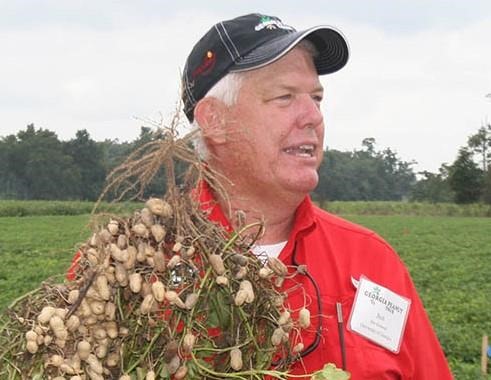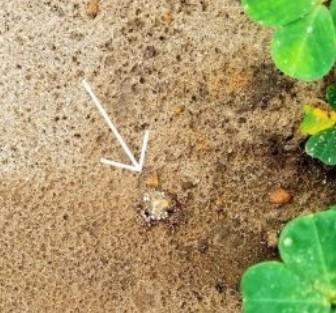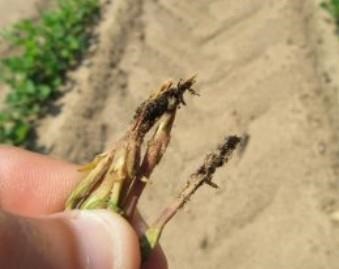By Nick Dufault and De Broughton
Peanut planting has already begun in Florida, so preseason decisions, such as varietal selection, and in-furrow applications have already been made by many peanut growers. Thus, decisions for management of Tomato Spotted Wilt and nematodes are mostly done. Now it is time to switch gears and start thinking about early season disease management options for our common fungal pathogens, which are peanut rust, leaf spot diseases, stem rot/white mold, and crown rot.
Peanut rust

Peanut rust pustules on the underside of a peanut leaf. Credit: N. Dufault, UF/IFAS
We saw a re-emergence of peanut rust during the 2020 field season which probably has this disease on many producers’ minds in 2021. Peanut rust can be a devastating disease if left unchecked, but luckily many of our leaf spot fungicides also manage this disease. Typically, we do not need to concern ourselves with rust early in the season, as this disease is generally spread from more tropical climates where volunteer hosts are abundant. This means it takes some time for rust to appear in our peanut production fields, as was the case last year when it began to be identified in late August and early September. Thus, our major concern with peanut rust early in the season is that we are scouting for this disease and monitoring for any early introductions. More information about peanut rust can be found in the article, The What, When and How of Florida’s Peanut Rust Issue
Leaf spot diseases

Late and early leaf spot symptoms and signs on peanut. Credit: N. Dufault, UF/IFAS
Peanut leaf spot diseases are an annual problem for Florida’s peanut producers. These leaf spot diseases are caused by two different leaf spot pathogens, and we have both show up in Florida every year. Typically, we see more early leaf spot in the Suwannee Valley and more late leaf spot in the Panhandle. However, it is not uncommon to have different leaf spot pathogens in neighboring fields. This means we need to have a good mixture of fungicide products in our programs, as our generic products (e.g. tebuconazole, azoxystrobin and pyraclostrobin) all vary in how they manage each pathogen.
Probably the biggest question related to peanut leaf spots disease management is: “When do I pull the trigger and apply my first spray?”. There is no simple answer to this question, as leaf spot disease onset can occur anytime between 25 and 90 days after planting (DAP). However, if we are looking to delay our first fungicide application, then we must focus on reducing our risk for leaf spot disease as much as possible. Peanut Rx is an excellent tool to provide insights related to this risk reduction. Typically, leaf spot disease quantity, as well as onset, is dependent upon variety, crop rotation, in-furrow treatments, and the timely application of fungicides. Having a resistant variety in a well rotated field, 3 or more years away from peanut, and applying either Velum or Thimet in-furrow will likely delay disease onset. Each of these factors alone will have an impact on peanut leaf spot, but it is always better to integrate these techniques, as their impact can change from season to season. If these techniques are implemented, then we can start to consider delaying our first fungicide application until about 40 DAP or a little later. Growers are encouraged to consult with UF/IFAS extension and with ag-chemical representatives to better understand how and when to delay their leaf spot disease management program.
Stem Rot/White Mold

An example of early season stem rot developing on a peanut seed away from the plants. Credit: N. Dufault, UF/IFAS
The impact of stem rot on Florida peanut production is variable across the state, but when this disease is severe it can have a tremendous impact on yields. Stem rot was apparent in the 2020 peanut season, which was partly due to the warm conditions experienced periodically throughout the season. Fields with a history of stem rot, or ones in a reduced rotation, should consider an early banded application, before 60 DAP, of the fungicide Proline™. This is especially true in peanuts planted before the third week in May. Scouting is also critical for effectively managing this disease, as Dr. Kemerait noted many peanuts can stay in the ground 150 days, meaning more attention needs to be given to this disease besides protecting the crop at the traditional 60 and 90 DAP (Southeast Peanut Farmer, pg 16). This includes early season scouting and management, especially in fields with a history of stem rot.
Aspergillus and Rhizoctonia Crown Rot

Aspergillus crown rot on peanut showing the black spores produced by the fungus. Credit: E. Carter, UF/IFAS
Unfortunately, there are no economically viable management options for crown rot diseases once the furrow has been closed. However, early season monitoring of these pathogens is critical, as it can significantly impact your management decisions for 2022. Not all crown rot pathogens are created equal and there are a few more options available for the management of Rhizoctonia spp. than Aspergillus niger. This means the proper identification of the pathogen is needed, and it is recommended that growers contact UF/IFAS Extension or a diagnostic lab when a crown rot issue is present.
Source : ufl.edu